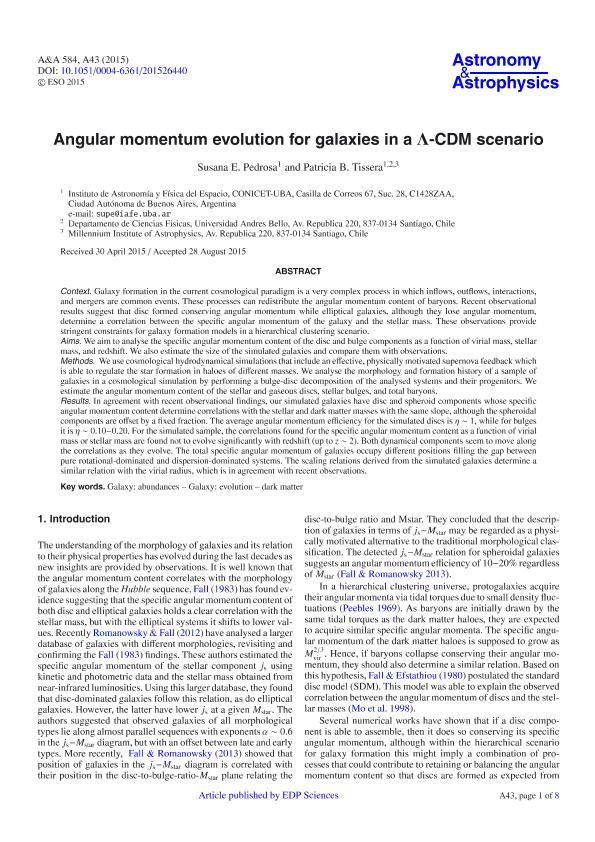Mostrar el registro sencillo del ítem
dc.contributor.author
Pedrosa, Susana Elizabeth

dc.contributor.author
Tissera, Patricia Beatriz

dc.date.available
2017-06-13T18:13:17Z
dc.date.issued
2015-12
dc.identifier.citation
Pedrosa, Susana Elizabeth; Tissera, Patricia Beatriz; Angular momentum evolution for galaxies in a Λ-CDM scenario; EDP Sciences; Astronomy & Astrophysics. Supplement Series (print); 584; A43; 12-2015; 1-8
dc.identifier.issn
0365-0138
dc.identifier.uri
http://hdl.handle.net/11336/18115
dc.description.abstract
Context. Galaxy formation in the current cosmological paradigm is a verycomplex process in which inflows, outflows, interactions, and mergersare common events. These processes can redistribute the angular momentumcontent of baryons. Recent observational results suggest that discformed conserving angular momentum while elliptical galaxies, althoughthey lose angular momentum, determine a correlation between the specificangular momentum of the galaxy and the stellar mass. These observationsprovide stringent constraints for galaxy formation models in ahierarchical clustering scenario. <br /> Aims: We aim to analyse thespecific angular momentum content of the disc and bulge components as afunction of virial mass, stellar mass, and redshift. We also estimatethe size of the simulated galaxies and compare them with observations.<br /> Methods: We use cosmological hydrodynamical simulations thatinclude an effective, physically motivated supernova feedback which isable to regulate the star formation in haloes of different masses. Weanalyse the morphology and formation history of a sample of galaxies ina cosmological simulation by performing a bulge-disc decomposition ofthe analysed systems and their progenitors. We estimate the angularmomentum content of the stellar and gaseous discs, stellar bulges, andtotal baryons. <br /> Results: In agreement with recent observationalfindings, our simulated galaxies have disc and spheroid components whosespecific angular momentum content determine correlations with thestellar and dark matter masses with the same slope, although thespheroidal components are offset by a fixed fraction. The averageangular momentum efficiency for the simulated discs is η ~ 1, whilefor bulges it is η ~ 0.10-0.20. For the simulated sample, thecorrelations found for the specific angular momentum content as afunction of virial mass or stellar mass are found not to evolvesignificantly with redshift (up to z ~ 2). Both dynamical componentsseem to move along the correlations as they evolve. The total specificangular momentum of galaxies occupy different positions filling the gapbetween pure rotational-dominated and dispersion-dominated systems. Thescaling relations derived from the simulated galaxies determine asimilar relation with the virial radius, which is in agreement withrecent observations.
dc.format
application/pdf
dc.language.iso
eng
dc.publisher
EDP Sciences

dc.rights
info:eu-repo/semantics/openAccess
dc.rights.uri
https://creativecommons.org/licenses/by/2.5/ar/
dc.subject
Galaxy Formation
dc.subject
Galaxy Evolution
dc.subject
Cosmology Dark Matter
dc.subject.classification
Astronomía

dc.subject.classification
Ciencias Físicas

dc.subject.classification
CIENCIAS NATURALES Y EXACTAS

dc.title
Angular momentum evolution for galaxies in a Λ-CDM scenario
dc.type
info:eu-repo/semantics/article
dc.type
info:ar-repo/semantics/artículo
dc.type
info:eu-repo/semantics/publishedVersion
dc.date.updated
2017-06-13T14:13:35Z
dc.journal.volume
584
dc.journal.number
A43
dc.journal.pagination
1-8
dc.journal.pais
Francia

dc.journal.ciudad
Paris
dc.description.fil
Fil: Pedrosa, Susana Elizabeth. Consejo Nacional de Investigaciónes Científicas y Técnicas. Oficina de Coordinación Administrativa Ciudad Universitaria. Instituto de Astronomía y Física del Espacio. - Universidad de Buenos Aires. Facultad de Ciencias Exactas y Naturales. Instituto de Astronomía y Física del Espacio; Argentina
dc.description.fil
Fil: Tissera, Patricia Beatriz. Universidad Andres Bello; Chile. Consejo Nacional de Investigaciónes Científicas y Técnicas. Oficina de Coordinación Administrativa Ciudad Universitaria. Instituto de Astronomía y Física del Espacio. - Universidad de Buenos Aires. Facultad de Ciencias Exactas y Naturales. Instituto de Astronomía y Física del Espacio; Argentina
dc.journal.title
Astronomy & Astrophysics. Supplement Series (print)

dc.relation.alternativeid
info:eu-repo/semantics/altIdentifier/doi/http://dx.doi.org/10.1051/0004-6361/201526440
dc.relation.alternativeid
info:eu-repo/semantics/altIdentifier/url/https://arxiv.org/abs/1508.07220
dc.relation.alternativeid
info:eu-repo/semantics/altIdentifier/url/https://www.aanda.org/articles/aa/abs/2015/12/aa26440-15/aa26440-15.html
Archivos asociados
